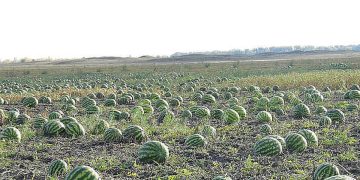#agriculture
#weedcontrol
#covercrops
#watermelon
#winterrye
#mustard
The success of vegetable crop cultivation in the dry steppe zone depends largely on the natural resources available, particularly the climate and soil. The soil in this region is heterogeneous, ranging from sandy to heavy clayey soils, which directly affects the nutrient availability for plant growth. It is crucial to select appropriate cover crops to maintain soil fertility and structure, as well as to combat the effects of environmental stressors such as wind erosion and drought.
According to recent studies by the Russian Ministry of Agriculture, the dry steppe zone presents several challenges to vegetable crop cultivation due to its specific soil conditions and environmental stressors. The granulometric composition of soil in this region is predominantly sandy or loamy, which poses challenges to water and nutrient retention. Additionally, the low content of organic matter in the soil exacerbates the effects of drought, leading to decreased crop yields. However, by incorporating cover crops such as legumes, farmers can enrich the soil with organic matter and fix atmospheric nitrogen, leading to improved nutrient availability for subsequent vegetable crops.
Furthermore, soil testing for nutrient levels is a critical step in successful crop cultivation. According to the National Soil Resources Institute, regular soil testing allows farmers to tailor their fertilization programs to the specific nutrient needs of their crops, preventing overuse of fertilizers and minimizing negative environmental impacts. Therefore, agronomists and agricultural engineers should encourage farmers to perform regular soil testing and provide recommendations for appropriate fertilization and nutrient management practices.
A study conducted at the Bykovskaya experimental station in the Volgograd region of Russia aimed to investigate the prolonged effects of different cover crops on soil nutrient content when cultivating watermelons. The study found that using cover crops increased the content of nutrients in the soil, leading to better and more stable crop yields. However, soil fertility is just one of many factors that determine the success of crop cultivation, especially in areas with unique climatic conditions.
The Bykovskaya experimental station is located in an area characterized by continental climate, with hot and dry summers, frequent dust storms, and high winds. In 2022, the average daily temperature during the growing season was below the multi-year average by 5.1-0.9°C, except for August, which had a temperature 2°C above the multi-year average. Rainfall was unevenly distributed, with the highest amount of rainfall (50.5 mm) occurring in June. The total amount of rainfall during the growing season was 136.5mm, 26.5mm lower than the multi-year average. The soil at the experimental station was light chestnut and sandy, with groundwater located at a depth of 8-10m.
The soil was found to be heterogeneous, with several layers ranging from gray, loose, and sandy at 0-30cm, to light gray, unevenly colored, and more clayey at 30-45cm. The layer at 45-90cm was light, structureless, and clayey, while the layer at 90-160cm was sandy, light, and loose. The most agriculturally valuable aggregates, ranging from 0.25mm to 10mm, constituted 40-45% of the soil, depending on the layer. Fine sand of 0.25mm made up a significant portion of the soil, up to 20%, indicating high water permeability.
Overall, the study suggests that cover crops can be an effective way of improving soil fertility, leading to better crop yields. However, farmers and agricultural experts must consider many factors when cultivating crops, especially in areas with unique climatic conditions. By taking a holistic approach to crop cultivation, including soil management, crop rotation, and irrigation, farmers can optimize their yields and ensure long-term sustainability.
The study found that the nitrogen content was higher in all treatments during the seedling stage, which can be attributed to the increase in soil microbial activity. Similar trends were observed for phosphorus and potassium, with the highest content observed for winter rye cover crop. However, the nutrient content decreased during fruit ripening stage in all treatments, including those of the second and third year.
The study’s results suggest that the selection of the appropriate cover crop can have a significant impact on soil nutrient content and, ultimately, on crop productivity. Farmers and agronomists should consider these findings when selecting a cover crop to improve soil fertility for watermelon crops. Additionally, regular soil testing can help farmers monitor soil nutrient levels and adjust their management practices accordingly.
Despite the dry conditions of the research zone, cover crops were found to be effective at suppressing weeds in crops of watermelon. Specifically, winter rye was the most effective cover crop in reducing weed damage. In addition, the use of mustard as a cover crop had a prolonged effect on weed suppression. These findings suggest that the use of cover crops can be an economically viable method for reducing weed damage.


































